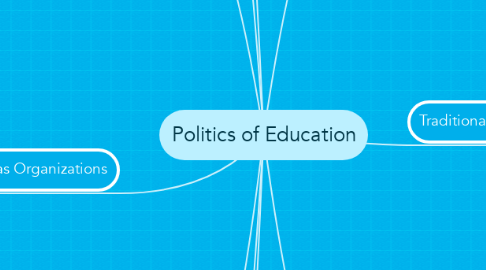
1. Conservative Perspective
1.1. Charles Darwin - Natural Selection: A variation in individuals decides who will survive and who will not survive.
1.2. William Graham Sumner looks at an individuals human and social evolution as how it adapts to environmental changes.
1.3. Individuals must compete in order to survive, progress is dependent on the individual.
1.4. Milton Friedman believed that the free market allows for maximizing of economic growth and individual liberty with competition.
1.5. Ronald Reagan's presidency was based on a conservative viewpoint.
1.6. Individuals make decisions using a cost/benefit scale.
2. Traditional Visions of Education
2.1. Schools promote traditional values such as hard work, family unity, and individual initiative.
2.2. Traditional education refers to customs found in schools that are deemed necessary.
2.3. William Bagley, a traditionalist, believed that progressive education damaged the intellectual and moral standards of students.
2.4. The traditionalist believes that the purpose of education is to pass on a body of knowledge (both factual and cultural) to future generations,
2.5. Robert Hutchins (a traditionalist) said, "Education is not an imitation of life but a preparation for life."
2.6. "Universal education has created an immense class of what I may call the New Stupid, hungering for certainty yet unable to find it in the traditional myths and their rationalizations." Aldous Huxley
3. Existentialism
3.1. People must create themselves. This is done by the choices they make in their lives.
3.2. Soren Kierkergaard proposed that people accept the existence of God. He rallied against the scientific approach to existence.
3.3. The goal of education should focus on the needs of individuals. Education should be concerned with individuality.
3.4. The role of the teacher is tremendous. A teacher must understand their role in order to be able to help their students. Teachers must teach the students to choose and act on their choices.
3.5. Method of instruction is thought to be personal. Each child is different and it is up to the teacher to find what works for each student.
3.6. The curriculum is focused more on humanities. Students should be exposed to problems as well as possibilities.
4. Curriculum & Pedagogy
4.1. State Senators: Richard Shelby and Jeff Sessions, House Representative: Mo Brooks, State Superintendent::Tommy Bice, Lauderdale County Superintendent: Jennifer Gray, Lauderdale County School Board: Jerry Fulmer, Chad Holden, Daniel Patterson,Ronnie Owens, and Barbara Cornelius
4.2. Humanist Curriculum -The purpose of education is to present to the students the best of what has been thought and written.
4.3. Mimetic Practice - purpose of education is to present knowledge to students.
4.4. Didactic Method - lecture or presentation is the main form of communication.
4.5. Educational process involves the relationship between the knower (the teacher) and the learner (the student).
4.6. William J. Bennett believed that there was a need for a traditional core of subjects and readings that would teach all students a common set of worthwhile knowledge..
5. Sociology of Education
5.1. Functionalists view society as a machine where one part works with another to produce the dynamic energy that makes society work
5.2. Emile Durkheim believed moral values were the foundation of society.
5.3. Functionalists believe that conflict represents a breakdown of shared values.
5.4. Most educational reform is based on the functional theories of schooling.
5.5. More schooling leads to greater knowledge and social participation.
5.6. A College degree is important for earning more money but there are other influences that factor in to the level of income that one receives.
6. History of U.S. Education
6.1. The Standards Era: 1980s-2012
6.1.1. A Nation at Risk - the educational foundations of our society are being eroded by rising mediocrity.
6.1.2. Conservatives wanted to restore both standards and the traditional curriculum.
6.1.3. Conservative critics argued that using make social problems better led to a mediocre educational system
6.1.4. No Child Left Behind Act - requires all public schools receiving federal funding to administer a statewide standardized test annually to all students.
6.1.5. Charter Schools - receive public funding but are independent from local district control.
6.1.6. Ravitch believes that the evolution of the U.S education has resulted in the dilution of academic excellence. Conservative and neo-liberal pursuits have not improved our schools or moved us closer to a fair and just society. She accuses the conservatives and neo-liberals of ignoring the effects of poverty on student achievement.
